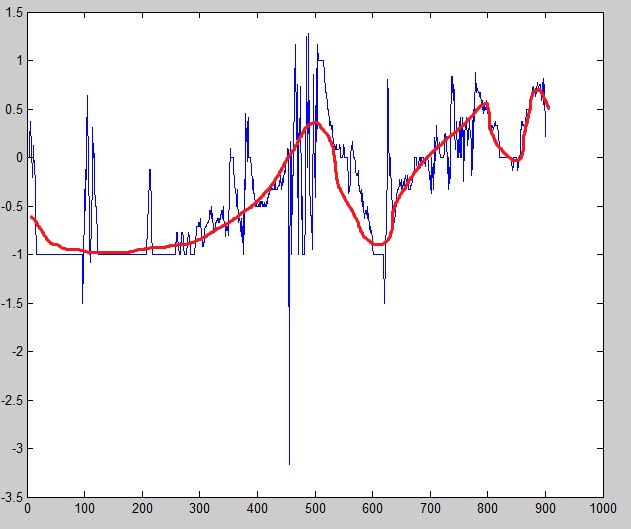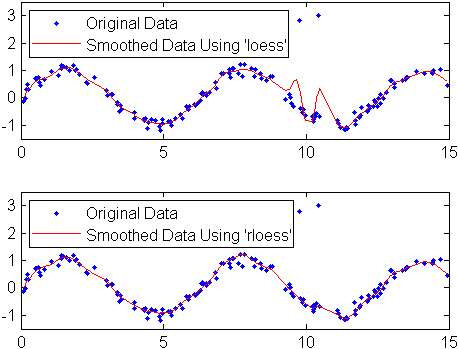You are looking for information on the topic “matlab smooth curve through points”. dongtienvietnam.com will gather information to answer your questions in this article. Please read this article to the end to find the information you want to see. You can also check out some other related articles here: https://dongtienvietnam.com/category/wiki/ smooth curve matlab, curve smoothing, smooth 2d curve matlab, smooth matlab, polyfit matlab, smooth interpolation matlab, matlab smooth data, matlab curve fitting.
View information about the matlab smooth curve through points
Information about this question
- Question: matlab smooth curve through points
- Time: Asked 1 days ago
- Modified: Asked 54 days ago
- View: 2363
matlab smooth curve through points
To smooth a curve through a set of points in MATLAB, you can use the “smooth” function or the “spline” function.
The “smooth” function in MATLAB applies a moving average filter to a set of data points. This filter smooths the data by replacing each data point with the average of the neighboring points within a specified window size. To use the “smooth” function, you can pass your set of x and y data points as arguments, along with the window size and a smoothing factor. Here’s an example:
scssx = 1:10; y = [5 6 5 4 8 7 9 6 5 7]; windowSize = 3; smoothedY = smooth(x, y, windowSize); plot(x, y, 'o', x, smoothedY, '-');
In this example, we create a set of x and y data points, specify a window size of 3, and call the “smooth” function to create a smoothed set of y values. We then plot the original data points as circles and the smoothed data as a solid line.
Alternatively, you can use the “spline” function to create a smooth curve that passes through your data points. The “spline” function fits a piecewise polynomial curve to your data points, and you can control the smoothness of the curve by specifying the number of knots. Here’s an example:
scssx = 1:10; y = [5 6 5 4 8 7 9 6 5 7]; knots = 5; xx = linspace(min(x), max(x), 100); yy = spline(x, y, xx); plot(x, y, 'o', xx, yy, '-');
In this example, we create a set of x and y data points, specify the number of knots as 5, and call the “spline” function to create a smooth curve that passes through the data points. We then plot the original data points as circles and the smoothed curve as a solid line.
Watch videos related to “matlab smooth curve through points”
Plot Smooth Curve from Limited Data using Spline in GNU Octave and Matlab
How to smooth 2d data in MATLAB?
There are several ways to smooth 2D data in MATLAB. Here are three common methods:
-
Using the
smoothdatafunction: This function can be used to smooth 2D data by applying different types of smoothing such as moving average, Gaussian, or lowess. Here’s an example of how to use it:matlab% Create example 2D data x = linspace(-3, 3, 100); y = linspace(-3, 3, 100); [X, Y] = meshgrid(x, y); Z = sin(X).*cos(Y); % Smooth the data using a Gaussian filter Z_smoothed = smoothdata(Z, 'gaussian', [5 5]); % Plot the original and smoothed data subplot(1,2,1) surf(X, Y, Z) title('Original Data') subplot(1,2,2) surf(X, Y, Z_smoothed) title('Smoothed Data') -
Using the
smooth2afunction: This function performs 2D convolution with a smoothing kernel. Here’s an example of how to use it:matlab% Create example 2D data x = linspace(-3, 3, 100); y = linspace(-3, 3, 100); [X, Y] = meshgrid(x, y); Z = sin(X).*cos(Y); % Smooth the data using a 5x5 averaging filter Z_smoothed = smooth2a(Z, 5); % Plot the original and smoothed data subplot(1,2,1) surf(X, Y, Z) title('Original Data') subplot(1,2,2) surf(X, Y, Z_smoothed) title('Smoothed Data') -
Using the
imgaussfiltfunction: This function performs Gaussian filtering of 2D data. Here’s an example of how to use it:matlab% Create example 2D data x = linspace(-3, 3, 100); y = linspace(-3, 3, 100); [X, Y] = meshgrid(x, y); Z = sin(X).*cos(Y); % Smooth the data using a 5x5 Gaussian filter with sigma=1 Z_smoothed = imgaussfilt(Z, 1, 'FilterSize', 5); % Plot the original and smoothed data subplot(1,2,1) surf(X, Y, Z) title('Original Data') subplot(1,2,2) surf(X, Y, Z_smoothed) title('Smoothed Data')
Note that the choice of smoothing method and parameters will depend on the specific characteristics of your data and the desired level of smoothing.
What is the difference between smooth and Smoothdata in MATLAB?
In MATLAB, “smooth” and “smoothdata” are two different functions that have similar but distinct purposes.
The “smooth” function is used for smoothing data using various smoothing techniques such as moving average, Savitzky-Golay, or Gaussian smoothing. It takes a vector or matrix of data as input and returns the smoothed version of the data as output. The syntax for the “smooth” function is:
scsssmoothed_data = smooth(data, window_length, smoothing_method);
Here, “data” is the input data, “window_length” is the size of the smoothing window, and “smoothing_method” is the type of smoothing to be used.
On the other hand, the “smoothdata” function is used for removing noise or spikes from data using a moving median or moving average filter. It takes a vector or matrix of data as input and returns the smoothed version of the data as output. The syntax for the “smoothdata” function is:
scsssmoothed_data = smoothdata(data, smoothing_method);
Here, “data” is the input data, and “smoothing_method” is the type of smoothing to be used.
Therefore, the main difference between “smooth” and “smoothdata” functions in MATLAB is that “smooth” is a general-purpose function for smoothing data using different techniques, while “smoothdata” is specifically designed for removing noise or spikes from data using moving median or moving average filters.
What does it mean for a curve to be smooth?
In mathematics, a curve is said to be smooth if it has no abrupt changes in direction or shape, and its derivatives exist and are continuous everywhere on the curve. In other words, a smooth curve is one that has no sharp corners, cusps, or singular points.
The concept of smoothness is important in many areas of mathematics, including calculus, differential geometry, and topology. In these fields, smooth curves are often used as models for physical objects or natural phenomena, and the smoothness of a curve is often related to its regularity, curvature, and other geometric properties.
Formally, a curve is said to be smooth if it is infinitely differentiable, meaning that its derivatives of all orders exist and are continuous. A curve that is only finitely differentiable, or has discontinuous derivatives, is said to be nonsmooth or rough. However, in practice, curves that are at least twice differentiable (i.e., have continuous first and second derivatives) are often considered “smooth enough” for most applications.
Images related to matlab smooth curve through points
Found 31 matlab smooth curve through points related images.




smooth curve matlab
To plot a smooth curve in MATLAB, you can use the plot function with a larger number of data points to achieve a smoother appearance. Additionally, you can use smoothing techniques such as moving averages or interpolation to further improve the smoothness of the curve.
Here is an example code snippet that generates a smooth curve using the plot function and interpolation:
matlab% Generate data x = linspace(0, 10, 100); % x-axis values y = sin(x); % y-axis values % Interpolate data to generate a smoother curve xx = linspace(0, 10, 1000); % new x-axis values for interpolation yy = interp1(x, y, xx, 'spline'); % interpolate y-axis values using cubic spline % Plot smoothed curve plot(xx, yy, 'LineWidth', 2) xlabel('x') ylabel('y') title('Smoothed Curve')
This code generates a smooth curve of the sin function using cubic spline interpolation. The plot function is used to plot the interpolated data, and the 'LineWidth' parameter is set to 2 to make the curve thicker and easier to see. The resulting plot should display a smooth curve that follows the shape of the sin function.
curve smoothing
Curve smoothing refers to the process of removing noise and other irregularities from a set of data points to create a smoother and more simplified curve that more accurately represents the underlying trends in the data. There are several techniques for curve smoothing, including moving averages, splines, and exponential smoothing.
Moving averages involve calculating the average of a group of adjacent data points over a sliding window, and using that average value to replace the original data point. This helps to smooth out fluctuations and highlight long-term trends.
Splines involve fitting a smooth curve to the data points by creating a series of polynomial functions that connect adjacent data points. This can provide a more precise and flexible representation of the data, but can also be more computationally intensive.
Exponential smoothing is a statistical technique that uses a weighted average of past observations to forecast future values. This approach is particularly useful for time series data, where there is often a trend and seasonality in the data.
Overall, the choice of curve smoothing technique will depend on the specific characteristics of the data and the goals of the analysis.
You can see some more information related to matlab smooth curve through points here
- How to create a smooth curve through data points? – MathWorks
- Plotting a smooth curve from points – MATLAB Answers
- How to plot a smooth curve with only a few points? – MathWorks
- Connecting Data points in a smooth curve – MATLAB Answers
- Smooth Data with Convolution – MATLAB & Simulink – MathWorks
- smooth vs smoothdata functions – MATLAB Answers – MathWorks
- 1. Exercises from 3.2 In this tutorial we’ll study different ways of …
- Plotting a smooth curve from points – MATLAB Answers
- Please, I want to get a smooth curve between two points
- Smoothing curve plot with some data points – MATLAB Answers
- How to create a smooth curve through data points? – MathWorks
- Smoothing – MATLAB & Simulink – MathWorks
- How to Plot a Smooth Curve in Matplotlib? – GeeksforGeeks
Comments
There are a total of 237 comments on this question.
- 531 comments are great
- 141 great comments
- 348 normal comments
- 160 bad comments
- 57 very bad comments
So you have finished reading the article on the topic matlab smooth curve through points. If you found this article useful, please share it with others. Thank you very much.